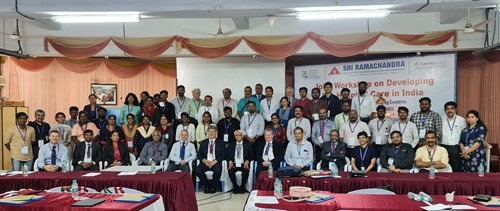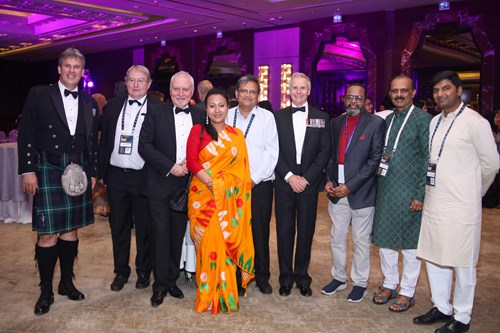
The Faculty of Pre-Hospital Care had previously been invited to support the development of pre-hospital care in India, via the Faculty of Disaster Medicine – India and Nepal, supported by Birmingham-based charity “Saving Lives”. International Development Lead Dr David Bruce, and conference speakers recently delivered a joint workshop alongside the RCSEd International conference in Chennai.
India has a mixed health-care delivery system. Policy recommendations in the 1940s laid the foundation for a government-funded, three-tiered public health system to deliver preventive and curative health services. By the 1980s, the private sector’s role in health began to gain prominence and nearly 70% of all out-patient visits and about 58% of inpatient episodes are now provided by either for-profit or not-for-profit private providers[1]. Central Government oversees policymaking, planning, guiding, evaluating and coordinating the work of State health authorities but health is a State responsibility and each State operates its own health facilities and determines how the Government’s aims and policies are delivered. This has led to variation in levels of care between States amplified by variations in geography and population density/care access.
Emergency Medical Service(s) (EMS) are a relatively new concept within India[2] and are evolving to reflect a change from a simple transportation system to a system in which medical care and resuscitation occur in transit. There are numerous models for EMS capabilities and systems in India have been described as ‘fragmented with no uniformity’. An emergency referral transport system was introduced under the National Health Mission and is available in 31 States and union territories; this is accessed through 108 and 102 toll-free numbers. 108 is a public-private partnership while 102 is a separate programme aimed at transporting pregnant women and children. In 2021, there were 19,290 ambulances operating under these schemes but the majority of ambulances do not provide advanced life support and there is limited data on the quality of care and response times. In addition to these schemes, there are private ambulance companies; ambulances may also be despatched from hospitals. In terms of trauma workload, there were over 155,000 road traffic deaths in India in 2021[3]; clearly, there are many more serious and lifechanging injuries with economic, personal and family consequences.
It was against this background, and the consequent health needs, that the FPHC decided to take advantage of UK speakers’ presence in Chennai for the RCSEd International Conference to cooperate with the Faculty of Disaster Medicine – India and Nepal and the Sri Ramachandra Institute of Higher Education and Research (SRIHER) to put together a Joint Workshop on developing pre-hospital care (PHC) in India. Dr Peter Patel of the Faculty of Disaster Medicine and Professor Ramakrishnan of SRIHER invited key speakers from India and Nepal to the Workshop which was held on 7/8 October 22. I subsequently constructed a timetable with the aims of sharing current PHC initiatives in India; discussing the applicability of some UK capabilities; identifying capability gaps that could be addressed; introducing the FPHC Pre-Hospital Trauma Course (PHTC); and establishing networking opportunities.
Ultimately, we had 10 speakers from different States in India, 5 UK speakers and a speaker from the Nepal Disaster and Emergency Medicine Centre in Kathmandu. A 2nd morning was added to the Workshop to allow further discussions and launch the 1st Edition of an Emergency Services First Aid Drills Aide Memoire.

The Workshop opened with a remote presentation from the Chair of the FPHC. Professor Vijayaraghavan, Vice Chancellor of SRIHER, then added his welcome and highlighted the importance of early resuscitative care both to survival rates and longer-term outcomes. Dr Thangalvadi, former Head of EM and Director of Premier Hospital Hyderabad, gave an excellent overview of the different ambulance systems existing in the country and pointed out that India’s 1st public service ambulances (15 vehicles) were only established in Mumbai as recently as 1985. Prior to 1985, patients were transferred to hospital in 3-wheel auto-rickshaws or in ambulances sent out from the hospital; outcomes were poor. He was followed by Dr Subroto Das of the Lifeline Foundation who established the Highway Rescue Project in 2002 to reduce the number of deaths on State highways after his wife sustained very serious injuries and took 5.5 hours to reach hospital. More recently, he has focused his efforts on training the population to provide high quality CPR in India’s techno-cities and to also use alternative-healthcare practitioners who are already established in communities. He highlighted that studies of private ambulance services had revealed that there was no regulation, crew training was variable and that equipment was either not working or staff had not been trained in its use in 20 – 70% of cases.
Professor Ramesh of Ramaiah Medical College, Bengaluru highlighted that 50% of acute coronary syndrome patients in the 30-70 year-old age group died before reaching hospital. This had prompted her to set up a hub-and-spoke system and ECG telemedicine capability to reduce time to thrombolysis. She had also introduced a stroke and chest pain awareness campaign allied with CPR training for communities. Further initiatives were introduced by Professor Vijayasankar of the Government Kilpauk Hospital and these included a trauma registry, speedier thrombolysis and triage tools to aid junior clinicians allied with education.
From the UK, Dr Rod Mackenzie described the evolution of PHC, trauma systems and the introduction of the Pre-Hospital Emergency Medicine sub-specialty before handing over to Professor Mark Wilson who outlined technological developments could aid effective PHC. Most significantly, he introduced the GoodSAM App which we could see dovetailing with some of the other speakers’ initiatives. Dr Pragya Mallick had trained in Chennai/India and was now a PHEM trainee in the East of England. ; she gave a unique insight into her career development. I introduced the FPHC Pre-Hospital Trauma Course which we plan to run at SRIHER in 2023 allied with a Train the Trainers course with the intention of the course rippling out across India.
Day 1 was rounded off by our host Professor Ramakrishnan describing the variations in ambulance personnel training and how SRIHER had introduced a 4-year degree course but that most graduates left India as their status and remuneration was much greater in the Middle East. We agreed that a system of paramedic registration and defined scope of practice were important topics for development but were a long-term goal.
On Day 2, Dr Maharjan from the Nepal Disaster and Emergency Medicine Centre outlined the nation’s ambulance capability. Two regions of the country have a toll-free 102 Service but crew training and equipment is variable. In order to address this issue, the Centre have produced a First Aid handbook in Nepali and delivered advanced, community and maternal health first aid courses to > 12,000 citizens. We then introduced the 1st Edition of an Emergency Services First Aid Drills Aide Memoire; it was based, with permission, upon a publication by Colonel (now Major General) Tim Hodgetts and had been updated by FPHC and Indian contributors. The Aide was universally supported and an initial print run of 500 has been funded by the charity Saving Lives for distribution to trained personnel in India.
In conclusion, the Workshop achieved the intended aims and a number of work strands are being taken forward by the FPHC and colleagues.
Written by:
Dr David Bruce
Chair of Training and Standards Committee and International Development Lead FPHC RCSEd

References:
[1] Selvaraj S, Karan K A, Srivastava S, Bhan N, & Mukhopadhyay I. India health system review. New Delhi: World Health Organization, Regional Office for South-East Asia; (2022).
[2] Emergency Medical Service in India: A Concept Paper by National Health Systems Resource Centre (Undated)
[3] Accidental Deaths and Suicides in India from National Crime Records Bureau (2021)
Due to essential systems maintenance and upgrades there will be intermittent interruptions to some on-line services on Saturday 27th of February. There will be further interruption to some core services on Wednesday 2nd and Thursday 3rd of March.
We apologise for any inconvenience caused.
×